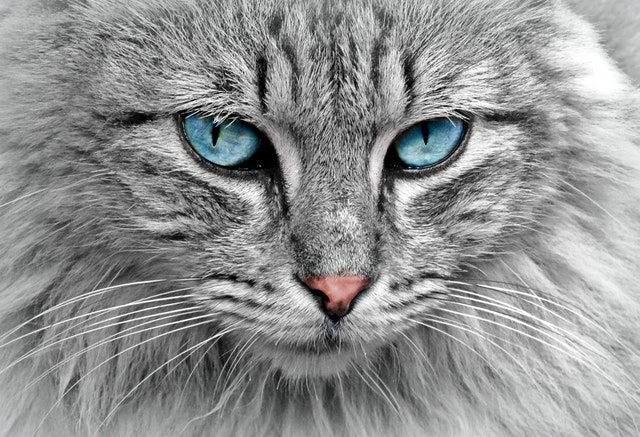Anecdotal research reveals that some cats thrive on raw diets, but only if their owners reduce the hazards associated with raw feeding.
Numerous commercial cat meals include an excessive amount of carbs, which may lead to various health issues in cats. In addition, their protein sources are often of low quality and frequently include fake additives. These concerns and anxieties, triggered by several pet food recalls, have persuaded many cat owners to explore alternatives, such as raw diets.
The Advantages of Raw Diets for Cats
Raw diets are gaining popularity as many individuals prepare natural cat food at home or buy commercially available raw food diets. Anecdotal data suggests that many cats given nutritionally balanced raw meals may have the following benefits:
- Weight reduction
- Coat with a glossier sheen
- Reduced stool volume, frequency, and odor
- Better dental health and breath
- Overall better health
Several problems are involved with raw foods, especially those produced at home, which is why many vets advise against them. However, proponents of raw diets claim that the advantages exceed the hazards if the risks are mitigated.
Raw Diets and Parasite Infection
A raw diet is more similar to what a cat would consume in the wild, but feral cats are often infected with parasites. According to the USDA, many parasites can be destroyed by freezing, but absolute certainty can only be obtained under well-controlled settings. Depending on the kind of meat, it might take anything from a few days to many weeks.
Although freezing won’t eliminate all parasites, adding this step before thawing and cooking lessens the danger. Freezing deactivates but does not destroy pathogenic microorganisms. Therefore, when the meat is frozen, these germs will once again be able to cause sickness.
Salmonella and Raw Diets
According to research, in 2001, twenty percent of raw meat samples from supermarket shops in Washington, DC, were infected with salmonella germs (White et al., 2001). However, in 2003, just 3.6% of meats were tainted, according to the University of Wisconsin-Madison School of Veterinary Medicine’s analysis of USDA statistics. Although many pets who ingest salmonella germs may become carriers (perhaps transmitting the disease to people through feces and saliva), some cats and dogs get ill.
Salmonella infection is more prevalent in humans than in cats and dogs. There are an estimated 1,400,000 instances every year, with a tiny number of cases being deadly (University of Wisconsin-Madison School of Veterinary Medicine, n.d.). Salmonella disease may exhibit any or all of the following symptoms:
- Abdominal discomfort
- Loss of appetite
- Diarrhea
- Fever
- Headache
- Lethargy
- Nausea
- Vomiting
Salmonella germs are widespread in chicken, one of the most refined protein sources for raw-fed cats. At least two raw-fed cats have died of salmonella infection (Martin, 2005), and other bacteria in raw foods may also cause disease in cats.
- Cat owners who prefer to give their cats raw food may limit the danger of bacterial infection by performing the following:
- To acquire fresher cuts, purchase meat directly from reliable suppliers instead of retailers.
Refrigerate meat rather than allowing it to defrost on the counter. - Use whole chunks of meat and rinse them with water before serving to eliminate as many surface germs as possible.
- If you wish to use ground beef, grind it yourself at home under hygienic circumstances; do not buy it from a grocery store since it may contain germs.
- If preparing food in large quantities, immediately freeze parts that will not be consumed immediately.
- Do not keep food out for an extended period after serving.
After each meal, clean the cat’s dishes and feeding utensils with hot soapy water and any containers used to store cat food.
These methods minimize the danger but do not eliminate it. A safer approach to serving raw food is to rapidly cook just the surfaces of whole meat pieces to destroy germs clinging to the outside while leaving the inside uncooked.
The Dangers of Raw Diets and Bones
Because the meats used in pet food are frequently deboned, bone meal is commonly included to replenish calcium and other minerals. Several ways give these nutrients in raw diets, including feeding entire prey, grinding bones into the meat, adding bone meal powder to the food, and providing meaty bones to chew (some believe that this also promotes dental health).
More significant bits of bone may shatter and get lodged in a pet’s mouth or digestive system or even penetrate the gastrointestinal tract (raw bones are less likely to crack than cooked bones, but there is still a risk). Raw-feeding proponents contend that cats consume bones in the wild, although cats’ natural food — mainly mice and small birds — is far smaller than the bones offered in raw diets. In addition, cats do not often cope with such giant bones, which might cause them to shatter their teeth.
Those contemplating raw diets should also be aware that excessive consumption of bone-in meat might cause constipation and other health issues. Therefore, owners must provide a healthy ratio of bone to heart in the diet.
Uncooked Diets and Malnutrition
Raw feeding is a more sophisticated procedure than just placing raw meat slices into a dish. Creating nutritionally adequate cat chow includes correcting discrepancies between commercially available beef and natural prey by altering or adding as appropriate. It is also necessary to tailor the food to the cat’s medical requirements since cats with health conditions such as renal disease or pancreatitis may need unique nutritional changes.
If you want to give your cat a raw diet but lack the time and money to study, plan, and make nutritionally adequate raw food, we can help. Natural cat food Various raw diets are commercially accessible. If buying a commercial diet, avoid ones that include excessive amounts of veggies and grains, which cats would not consume in the wild. The veterinarian Lisa Pierson suggests Feline’s Pride, devoid of grains and vegetables, and Nature’s Variety, which includes just 5% plant-based components.
It is challenging to feed cats with a balanced diet. However, those who fail to conduct their study and arrange the diet appropriately, ideally in partnership with a veterinarian friendly to raw feeding, may put their cats in danger of significant health issues or even death.

